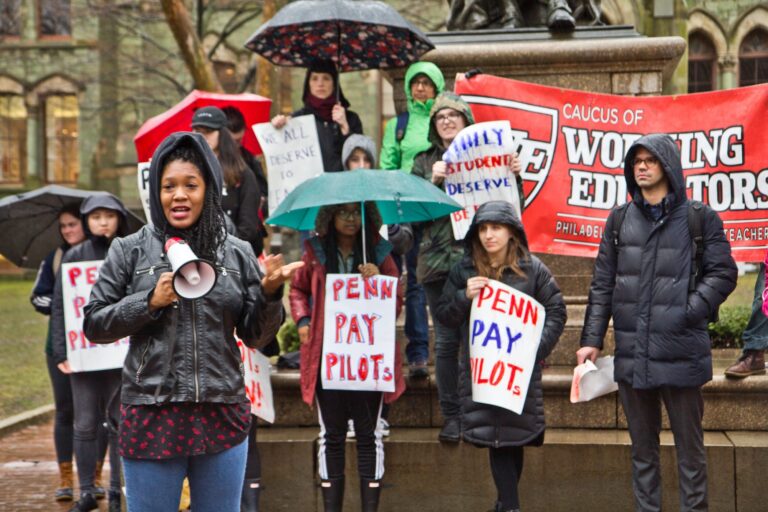Penn’s $100 million pledge has a backstory
Activists have called for UPenn to support city schools for years. So why is Penn giving now — and what does it mean for the future?
Listen 16:39
Gina Dukes, a Penn alumna and a Philadelphia school district teacher, speaks at a rally to demand UPenn make PILOT payments. (Kimberly Paynter/WHYY)
Christmas came early this year for the Philadelphia School District. The University of Pennsylvania pledged $100 million to go toward fixing unsafe school buildings. Over the next decade, the Ivy League institution will send $10 million to city schools each year — the largest private contribution to the School District ever made.
Activist leaders on campus and across the city have called for a donation like this for a long time. They want Penn to pay payments in lieu of taxes, known as PILOTs, calling foul on the regulations that allow a nonprofit that owns $3.2 billion in city real estate to skip property taxes. Like the tax dollars contributed by other property owners in the city, their payments could towards public schools and infrastructure, these critics say.
Emily Dowdall, policy director of Reinvestment Fund, says the university has instead chosen to invest in public amenities in its own backyard, like the Penn-funded elementary school in West Philadelphia where university employees and their neighbors in the area can now send their children. She explains why Penn is now turning its attention to the school district as a whole and the difference the donation could make.

Hear the whole story on The Why
Interview highlights
On the cases for PILOTs
Not every nonprofit is created equal. There are some tiny one-room nonprofits located in neighborhoods throughout the city that do things like tutoring or organize neighborhood cleanups…these do-gooder organizations where they don’t have a lot of extra cash on hand. But then you compare that to an Ivy League university, [a] world-class university with an endowment that is in the billions. […]
And so the idea is these wealthier nonprofits have both the ability and sort of a responsibility to give back to their communities. Some of the arguments for PILOTs are also equity-based, in that these institutions may themselves be very well-off and located in cities that are struggling. Philadelphia is well known for having the highest poverty rate among the 10 largest [U.S.] cities. And then we have some very wealthy institutions. And so people take a look at that and they think, this isn’t fair; this would be a good place to look to to sort of spread some of that wealth around.
On why Penn is pledging this $100 million now
I think there’s a lot of reasons why the university is interested in making this donation at this time. I think some of that has to do with the activism around PILOTs. And I think some of it has to do with the new focus on school building quality as there have been debates over reopening the schools during this coronavirus pandemic that we’re in. And also the racial justice conversation that we’ve been having in this country, and, of course, in the city of Philadelphia, with the killing of Walter Wallace Jr. There are so many reasons that folks are now focused on inequity, on school building quality, and the connection between physical facilities and health. […]
I think the environment as such is one in which not acting becomes less of a viable strategy if you want to be seen as a leader in addressing the world’s greatest problems, which I think Penn wants to be seen as. So what do you do with the fallout of the pandemic? What do you do with the conversation about racial justice and institutional racism? Well, this is a way that Penn can really be a leader on those fronts. And why Penn and not Jefferson or Drexel or Temple? Well, I think a lot of it has to do with Penn, again, being much larger in size in terms of the number of people they employ, as well as having that larger endowment. I know that a lot of the sort of response in the last few days as this news came out was: We hope that it’s not just Penn. This needs to be a signal to the other institutions that they should also come in and make a substantial contribution at this time.
On the difference Penn’s donation will make for the school district
It’s not $100 million all at once, it’s actually spread out over 10 years. So it’s more of a down payment on what the school district needs to invest in its facilities, to really bring them up to good standing for every student across the district.
At the same time, it’s not nothing. It’s really important, especially at this time. This is such a critical point to invest in our school facilities for the future, and I think it’s such an important time for leaders in the city, both public sector leaders and also civic sector leaders like the leadership at Penn to really show that they get this need to commit to racial equity as well.
 WHYY is one of over 20 news organizations producing Broke in Philly, a collaborative reporting project on solutions to poverty and the city’s push towards economic justice. Follow us at @BrokeInPhilly.
WHYY is one of over 20 news organizations producing Broke in Philly, a collaborative reporting project on solutions to poverty and the city’s push towards economic justice. Follow us at @BrokeInPhilly.
WHYY is your source for fact-based, in-depth journalism and information. As a nonprofit organization, we rely on financial support from readers like you. Please give today.






